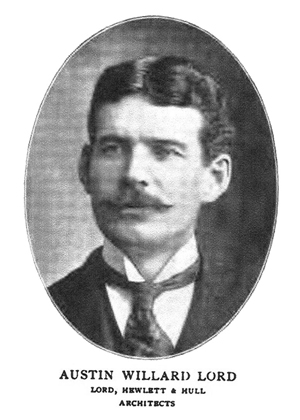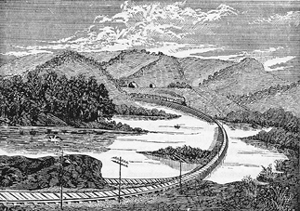Austin Willard Lord, Artist and Architect

1860-1922
by Walt Bennick,
Winona County Historical Society
Austin Willard Lord, the son of Orville and Martha (Deming) Lord, was born in Minnesota City, Rollingstone Township, Winona County, Minnesota on June 27, 1860. Austin was educated in the Winona County Public Schools and graduated from Winona State Normal School in May of 1881. While attending the normal school Austin studied architecture and drawing under Miss Catherine M Ball. After a short stint in teaching, Austin found employment in an architectural office in the St. Paul - Minneapolis area. However he soon moved to Boston, Massachusetts in order to extend his career in architecture.
Austin returned to Winona and was married to Miss Margaret Elizabeth Gage at the home of her parents on Tuesday, January 4, 1887 at 2:30 PM by the Rev Levi Gilbert, pastor of the Central Methodist Church. Margaret, the daughter of Alvah and Christina (Gage) Gage, was born in August 30, 1861 in Winona, Minnesota. Following their marriage, the couple returned to Boston where Austin entered the Massachusetts Institute of Technology where he studied architecture under Professor William R. Ware. After a year of study, Austin entered the architectural offices of Arthur Rotch and George Tilden of Boston as a draftsman. The position was a part of a scholarship program by Mr. Rotch which included two of employment and two years of study in Europe, one year in Paris working in the workshop of Honore Daumet and Charles Girault and the second traveling around Europe, studying and sketching various buildings. While studying in Europe Austin Lord described his travels in England for the Winona Daily Republican newspaper. He wrote about the variety of buildings he was seeing and sketching.
It appears that while Austin was studying in Europe, his wife was living with her mother in Winona. However, when Austin returned to the United States on July 12, 1890, his wife returned to New York to meet him. Austin brought with him on his return some 600 fine sketches and drawings. Following his return to America, Austin Lord entered the architectural firm of Charles McKim, William Mead and Stanford White where he remained until the autumn of 1894. In that year he was appointed director of the American School of Architecture in Rome, a position he held for two years. The school was organized by Charles McKim while he led a group of American artists to plan for the 1893 World's Columbian Exposition. It was a place for American artists to study aboard.
During his stay with McKim, Mead and White, Austin was engaged in such important work as the new Columbia University buildings, the Brooklyn Institute of Arts and Sciences buildings and the Metropolitan Club of New York City. Prior to going abroad in 1894, Austin Lord entered into a partnership with James Hewlett and Washington Hull under the name of Lord, Hewlett and Hull.
In the later part of the 1890s, Austin's firm of Lord, Hewlett and Hull had submitted a design and plans for a new University of California at Berkeley with some $25-million that had been donated by Mrs. Phoebe Hearst. Unfortunately, the design of the campus was given to another architect. In 1901, the firm of Lord, Hewlett and Hull received another commission from the federal government to design the new $2-million agricultural building in Washington, D.C. and Austin received the appointment as the architect. Other undertakings included the design for a monument for soldiers, sailors and marines of the Civil War that was constructed in Philadelphia at a cost of a half a million dollars.
In 1912, Austin Lord was in Winona to plan two new mansions to be built by Rockwell Kent for the Frederick S. Bell and Samuel L Prentiss families at Briarcombe farms. Mrs. Bell was the former Frances Laird and Mrs. Prentiss was the former Maude Laird, both the daughters of William Harris Laird. Later that same year, Austin Lord was appointed to design the building needed in the maintenance and administration of the Panama Canal. Austin spent a part of the summer in the Canal Zone to see where the building was to be located. And before returning to New York, he returned to Winona to inspect the work being done at the Briarcombe Farms. When Austin returned to Panama in January of 1913, Frederick Bell accompanied him in order to see what was being accomplished.
Austin made several trips to Winona to inspect the Briarcombe mansions and in late 1916 he brought eighteen of his paintings for an exhibit at the Winona Public Library. Included in his exhibition were two paintings of Winona. In his later life, Austin Lord settled at Silvermine, an artist's community in Norwalk, Connecticut. Austin died there on January 20, 1922 at the age of 62 years. He was cremated and his remains where interred in a Brooklyn, New York, cemetery. He was survived by his widow, one son and two daughters. Following his death, his widow moved to Winona to live with her aged mother until her mother's death in 1926, after which she returned to the New York City area. She was living with her son, Jay, in Pennsylvania in 1940.

Rollingstone Valley, courtesy of
Winona County Historical Society
From the Archives
Austin Lord was not only an architect, but also an artist. One of his early sketches of the Rollingstone Valley was placed on page 205 of the 1883 History of Winona County, Minnesota" and is seen at left.
One of Austin Lord's building designs was also found near the Winona Country Club. It was the homes of the sisters, Maude (Laird) Prentiss and Frances (Laird) Bell. The mansions on their estate of Briarcombe Farm which was located at the entrance to Pleasant Valley. The mansions were constructed in the Georgian Renaissance style and were connected by an arcade. The families occupied their new homes in August of 1914. After the families died, their farm and homes were sold to Charlie Choate and by the terms of the sale, the Bell house had to be razed and its foundation would be used as part of a garage. Below is a photograph of the twin mansion just before they were occupied.

Briarcombe Farms, courtesy of Winona County Historical Society
